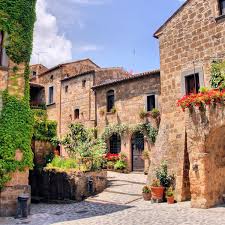Italy’s one euro houses: Who can buy one and how does it work?

I would like to be emailed about offers, events and updates from The Independent. Read our privacy policy
With property prices in the UK out of reach for many first-time buyers, and homeowners dreaming of a second pad in the sun, the idea of snapping up an Italian casa for 86p is intoxicating.
Several small Italian towns have hit the headlines for selling off vacant houses for €1 a pop in the past couple of years.
But how does the scheme work, and who is eligible to snap up one of these bargain villas in the sun?

Why is Italy selling houses for €1?
As young Italians increasingly migrate to the city and choose cosmopolitan jobs over rural and community vocations, many of Italy’s prettiest remote villages are becoming abandoned, with tiny, ageing populations that are beginning to die off.
Some elderly Italians have found themselves with no one to leave their house to, bequeathing it instead to the local authorities, who have to decide what to do with it, while some younger citizens have inherited properties in areas they have no intention of moving to.
Having a second home in Italy means paying taxes, so selling these unused houses off cheaply can be more lucrative than keeping them.
That’s why around 25 Italian municipalities are making prospective homeowners an offer they can’t refuse – a house for the symbolic price of €1.
The idea is, having these homes improved and occupied in the next few years is worth more to the towns than selling them off at full price.
“We do not need new constructions and new overbuilding. The strategy to improve the housing environment and reclaim our cultural identity is to revive the small abandoned centres or to redevelop buildings in a state of abandonment, with a story that is our history,” reads a statement by the team at 1eurohouses.com.
Local authorities in areas such as Emilia-Romagna, Abruzzo and Campania also hope an influx of new homeowners will stimulate the economy, as they buy local produce, employ local construction workers, pour money into local venues and attractions, and even boost tourism by creating boutique hotels or B&Bs.
What’s the catch?
You’re not buying a shiny new villa – houses selected for the scheme are often dilapidated and require major structural improvements. You’re investing in a fixer-upper, not acquiring a ready-to-move-in home.
However, the cost of renovations is still relatively low compared to other countries – in the region of €20,000–50,000 depending on the size of the property.
While most houses are humble village homes or cottages, some stately homes are also on sale, with a much higher price tag attached. The sellers of this former monastery outside Bologna estimate essential renovations could cost €1.5m.
Legal fees for buying a house abroad can add up to €3,000 on top of this, and some municipalities also ask for a “guarantee fee” (from €1,000 to €10,000 depending on the town and the cost of the renovation project) to prove you’re committed to improving the property.
On the upside, Italy does provide a ‘superbonus’ tax exemption for buyers that covers 110 per cent of qualifying building expenditures.
You won’t be able to make vague promises about refurbishing your new pad sometime in the future, either – new owners are required to submit details of a renovation project within two to 12 months of purchase (depending on the location), start work within one year, and complete it within the next three.
It’s also worth noting that not every property ends up being sold for just a euro. Popular houses have become the subject of a bidding war, with several going for €5,000 or even €20,000.
So this is a scheme for people who have some savings stored up beyond the initial euro.
Who can buy a one euro house?
“Is it true or is it a joke?” reads a section of the website case1euro.it, which lists €1 properties currently for sale in Mussomeli, 60 miles south of Palermo, Sicily.
It is not a joke. Rules differ from town to town, but in the case of Mussomeli, buyers must have the financial and practical wherewithal to:
Support all expenses for the drafting of the deeds of sale (notary, registration, transfer)
Prepare a project for the renovation of the property within one year of purchase, acquiring any permissions needed
Start work within two months of the date of issue of the building permit
Conclude work within three years
Put down a “guarantee policy” deposit of £5,000 (£4,314), which they will lose in the event that the work doesn’t go ahead within three years
In Mussomeli, you can do whatever you like with the interior of the property, but must keep the facade looking as it did originally.
Small print goes on to say that you are entitled to renovate the property yourself, or with your choice of workers.
This is the route that French buyer Morgane Guihot and her husband took, telling CNN in 2019: “As we’re both artisans and renovators we did most of the work ourselves, which was minimal, and it was great seeing our two-room house come to life again.”
Most towns who have set up a €1 house scheme have similar financial requirements – you’ll have to check the specific requirements of the town you want to buy in. Some require you to live in the house after renovations, while others allow you to buy it with a view to using it as a holiday home or as a small business such as a B&B.
Buyers who don’t have Italian residency or don’t speak Italian may run into more hurdles when it comes to organising work and being able to make use of their property.
Has Brexit affected Brits being able to buy the houses?
People living outside of the EU can still buy properties in Italy, but only as “non residents”. This means you pay higher taxes than locals, and can spend up to 180 days per year at your Italian house, but not more than 90 out of every 180 days.
To visit more regularly, you would have to apply for Italian residency, which includes proving you have sufficient funds to support yourself without employment in Italy.
I’m still interested. How do I get started?
You’ll find €1 houses for sale on websites such as 1eurohouses.com, case1euro.it and property-in-sicily.estate as well as on individual local government websites such as the Comune of Sambuca’s or Citta de Troina’s in Sicily.
Auctions2Italy also lists some €2 properties in the country, and you’ll find case studies and ‘How we did it’ guides on Europe.properties.
American buyer Rubia Daniels, who purchased and renovated a €1 home in Sicily, told Travel + Leisure in 2022 that going and viewing potential houses in person is a must; as is examining the foundations and state of the walls.
“Definitely don’t try to do it online — you need to be there to see it and experience the process to make sure you’re making a mindful decision,” said Daniels. “I wouldn’t do anything through the internet.”
“You don’t want to get anything where the walls are buckled because that indicates a foundation issue,” she advises.
Areas running €1 house schemes
Emilia-Romagna
The slice of northern Italy around Bologna has houses for sale in towns such as verdant, ancient-ruin-speckled Modigliana (where you can buy the aforementioned dilapidated monastery).
Abruzzo
The region hugging the coast to the east of Rome. Towns raffling off their vacant homes include Casoli, Santo Stefano di Sessanio and Pratola Peligna.
Campania
The dramatic, volcanic slice of coastline around Naples, close to Pompeii and the Amalfi Coast has some €1 properties for sale in places like near-abandoned Pietramelara, which recently has been home to just 15 families.
Sicily
Sicily is a hotbed of €1 house schemes. As well as sleepy Mussomeli, the towns of Calatafimi Segesta, Augusta, Sambuca and Caltagirone are all selling off unwanted or unclaimed houses.
Piedmont
This northern region near Switzerland is offering homes in towns like Borgomezzavalle and Albugnano, close to renowned wine producing regions and the outdoorsy, wooded Antrona Valley.
Le Marche
The medieval town of Cantiano – a 40-minute drive from the seaside – has €1 homes for sale near white-pebble Adriatic beaches and truffle-hunting spots.
Liguria
Triora and Pignone are two of the areas in this region, famous for the colourful fishing villages of Cinque Terre as well as pesto and foccacia.
Puglia
With 195,024 inhabitants, Puglia’s provincial capital of Tarento is one of the first bigger-scale towns to start up a 1 Euro Case scheme – putting buyers in touch with its maritime history and great seafood.
The towns of Romana and Nulvi sit in the island’s Sassari province outside of Alghero, and have both joined the scheme to sell off €1 homes.
Tuscany
Montieri, Grosseto, Lucca and Vergemoli are some of the participating towns in Italy’s hallowed wine and villa haven.




